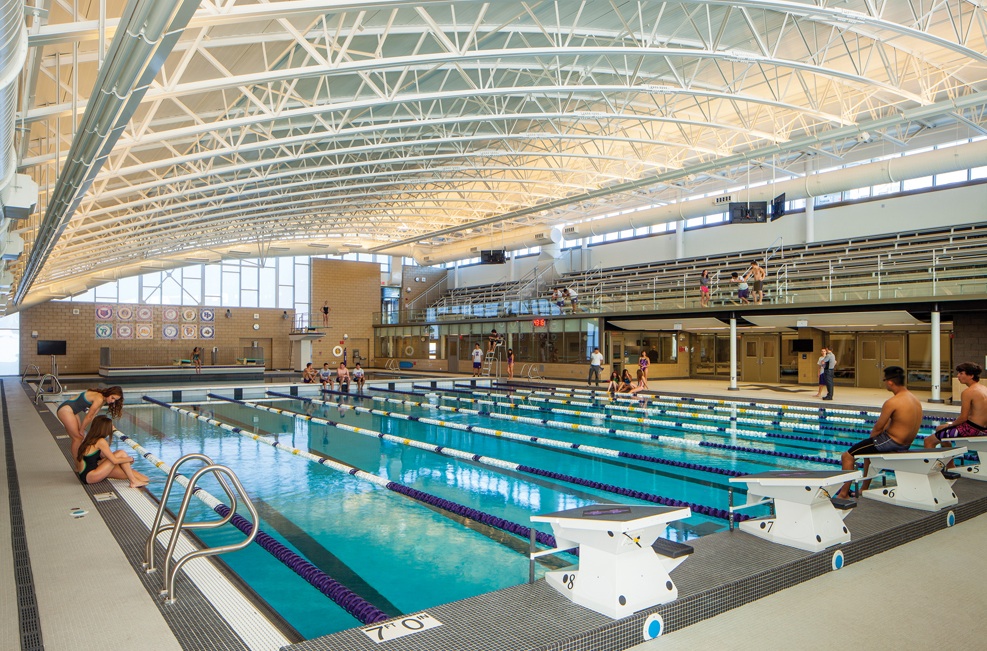The Building Team for the new Aquatics Center at Niles North High School in Skokie, Ill., included Chicago-area firms Legat Architects and IHC Construction—but a case could be made for listing a much larger group of official participants. The AEC firms made a concerted effort to involve not only district officials but also the user community. As a result, the project became a unique learning experience for students, staff, and neighbors.
The Niles North Aquatics Center serves 2,200 students—all of whom must take swimming—as well as 275 competitive student athletes in swimming, diving, and water polo. Feeder programs from park districts and local partners are also housed there. By 2012, the pool in the 48-year-old building was considered too small and shallow to meet current requirements.
Stakeholders asked for a new competition “cold pool,” a renovated community-accessible “warm pool,” a new public connecting corridor, locker room renovations, coaches’ offices, and meeting and storage space. Lighting and mechanical systems also needed an energy upgrade.
SILVER AWARD
Project summaryNiles North High School Aquatics Center
Skokie, Ill.BUILDING TEAM
Submitting firm: Legat Architects (architect)
Owner/developer: Niles Township High School District 219
Structural: KJWW Engineering Consultants
Mechanical/plumbing: AMSCO Engineering
Electrical: Hansen Palmer Associates
Civil: Gewalt Hamilton
CM: IHC Construction CompaniesGENERAL INFORMATION
Project size: 39,200 sf (24,600 sf new + 14,600 sf renovated)
Construction cost: $15 million
Construction period: April 2012 to August 2013
Delivery method: Design-bid-build
District 219 teamed with Legat Architects to plan the revitalization. Students and community members were surveyed regarding their priorities, and the Building Team held design workshops that elicited feedback for the floor plan. Daylighting is an important aspect of the final design, including a mix of clerestories, clear windows, translucent windows, and internal glazing to offer glare-free illumination and visual connections.
Eventually, the project was incorporated into the district’s architecture and engineering class curriculum. Biweekly tours were coordinated with faculty to focus on current classroom topics, and students were able to receive insights on various career paths.
“It became quite the living classroom,” says Building Team Awards judge Nathan Snydacker, PE, LEED AP, Vice President at Environmental Systems Design.
“It’s a lot of involvement you’d want in a school project of this type,” adds BTA judge Terry Fielden, LEED AP BD+C, Director of K-12 Education for International Contractors.
The Building Team phased construction over two summers to minimize disruption, keeping the community involved with a blog, video tours, signage with QR codes, and outreach to local news outlets.
In spring 2013, a severe flood created leaks in the lower-level filtration room. The damage stalled excavation and construction of the pool slab and walls, but IHC Construction, Legat, D219 staff, and other contractors managed to keep the job on schedule and within budget.
The result is a more functional, accessible, energy-efficient facility, designed to use 42% less water and 44% less energy than typical natatoriums. The project, whose heat-recovery dehumidification units should also sharply reduce CO2 emissions, is expected to become the first aquatic center in Illinois to achieve LEED for Schools Gold certification.
Related Stories
| May 18, 2011
Addition provides new school for pre-K and special-needs kids outside Chicago
Perkins+Will, Chicago, designed the Early Learning Center, a $9 million, 37,000-sf addition to Barrington Middle School in Barrington, Ill., to create an easily accessible and safe learning environment for pre-kindergarten and special-needs students.
| May 18, 2011
Raphael Viñoly’s serpentine-shaped building snakes up San Francisco hillside
The hillside location for the Ray and Dagmar Dolby Regeneration Medicine building at the University of California, San Francisco, presented a challenge to the Building Team of Raphael Viñoly, SmithGroup, DPR Construction, and Forell/Elsesser Engineers. The 660-foot-long serpentine-shaped building sits on a structural framework 40 to 70 feet off the ground to accommodate the hillside’s steep 60-degree slope.
| May 18, 2011
New center provides home to medical specialties
Construction has begun on the 150,000-sf Medical Arts Pavilion at the University Medical Center in Princeton, N.J.
| May 18, 2011
Improvements add to Detroit convention center’s appeal
Interior and exterior renovations and updates will make the Detroit Cobo Center more appealing to conventioneers. A new 40,000-sf ballroom will take advantage of the center’s riverfront location, with views of the river and downtown.
| May 18, 2011
One of Delaware’s largest high schools seeks LEED for Schools designation
The $82 million, 280,000-sf Dover (Del.) High School will have capacity for 1,800 students and feature a 900-seat theater, a 2,500-seat gymnasium, and a 5,000-seat football stadium.
| May 18, 2011
Carnegie Hall vaults into the 21st century with a $200 million renovation
Historic Carnegie Hall in New York City is in the midst of a major $200 million renovation that will bring the building up to contemporary standards, increase educational and backstage space, and target LEED Silver.
| May 17, 2011
Redesigning, redefining the grocery shopping experience
The traditional 40,000- to 60,000-sf grocery store is disappearing and much of the change is happening in the city. Urban infill sites and mixed-use projects offer grocers a rare opportunity to repackage themselves into smaller, more efficient, and more convenient retail outlets. And the AEC community will have a hand in developing how these facilities will look and operate.
| May 17, 2011
Architecture billings index fell in April, hurt by tight financing for projects
The architecture billings index, a leading indicator of U.S. construction activity, fell in April, hurt by tight financing for projects. The architecture billings index fell 2.9 points last month to 47.6, a level that indicates declining demand for architecture services, according to the American Institute of Architects.















